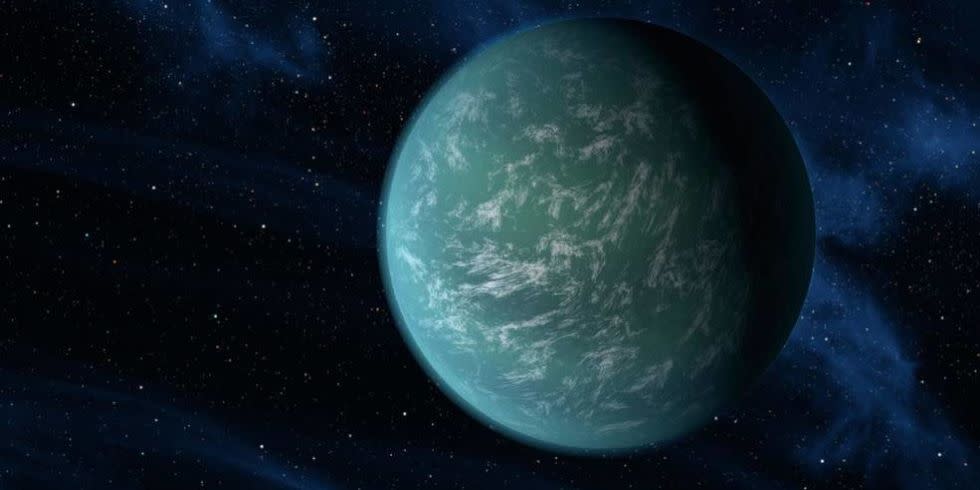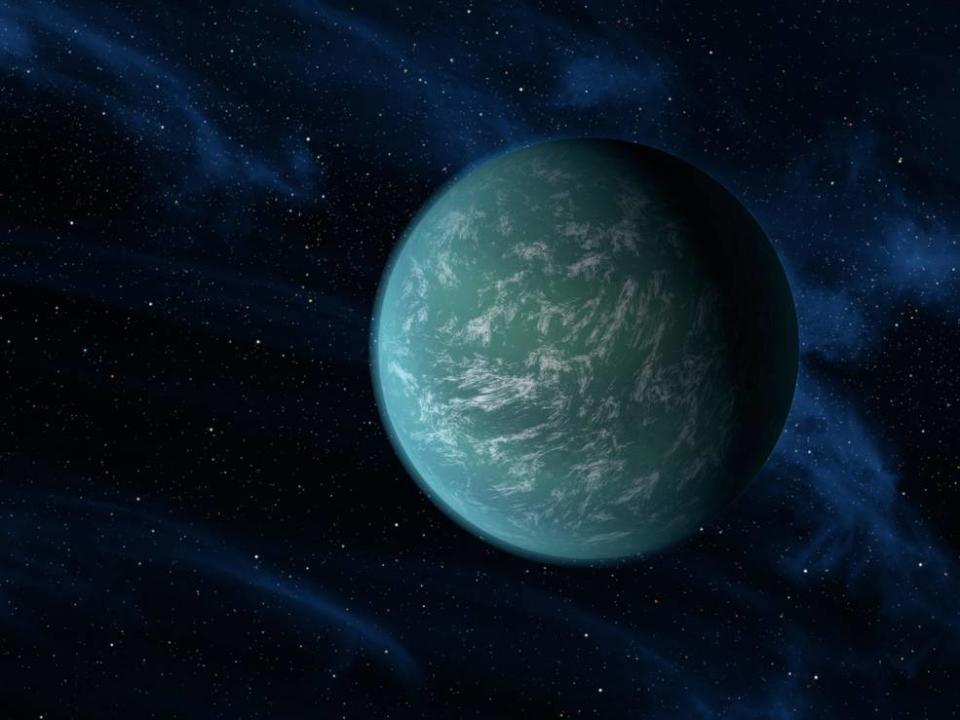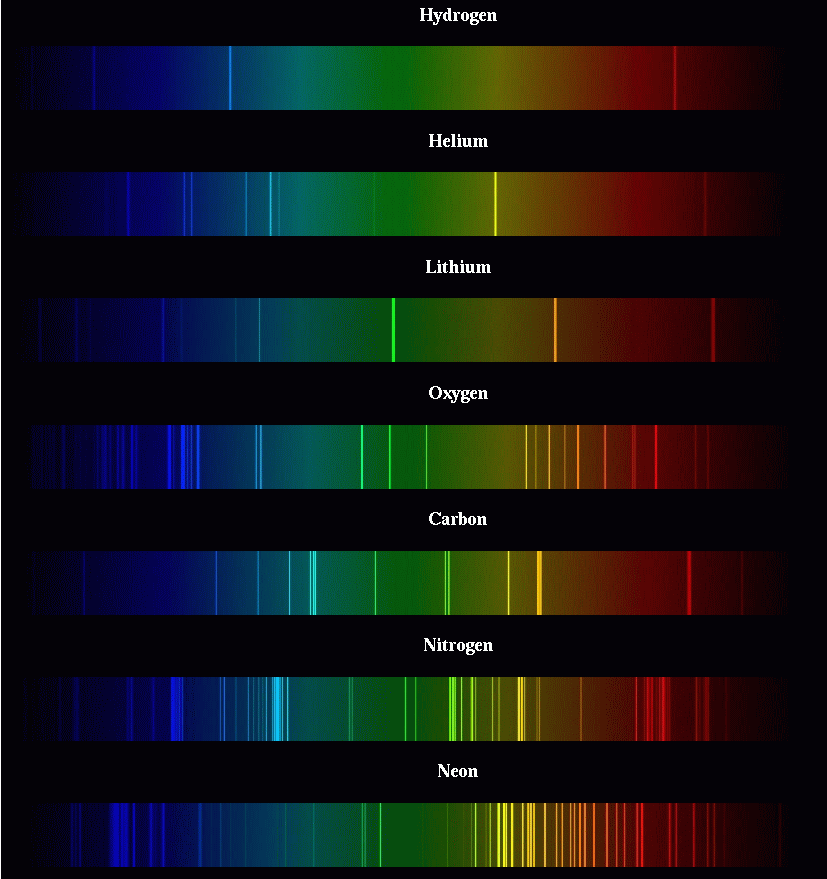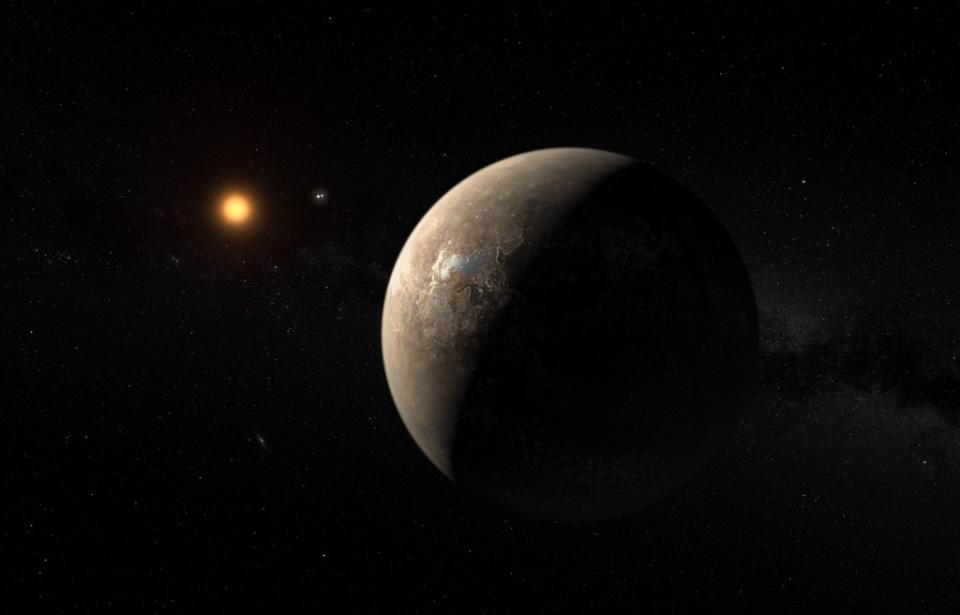How We Could Search the Atmospheres of Alien Planets for Signs of Life

We've been asking ourselves one universal question since the dawn of modern science: Are we alone? In the early days of astronomy, scientists thought the Earth was the center of everything. But when that Earth-centric view eventually changed and we realized that we orbit but one star among countless millions, we couldn't help but wonder what else might be out there.
It wasn't until 1992, when scientists discovered a planet around Pulsar PSR B1257+12, that astronomers were able to confirm what many had suspected-planets exist outside of our solar system. But how many?
Fast forward 25 years, and we now know of over 5,000 extrasolar planets, or exoplanets, thanks mostly to the Kepler space telescope. Not only that, but there are around 3,000 with their own atmospheres. Now astronomers work tirelessly to answer the tantalizing question-are some of the planets out there similar to our own?

A number of SETI researchers committed to answering this question recently gathered at Stanford University for the Breakthrough Discuss conference, an event hosted by the Breakthrough Initiatives founded by Russian billionaire Yuri Milner. Breakthrough is supported by the likes of Stephen Hawking, Mark Zuckerberg, Jill Tarter, and Frank Drake. The goal is simple and yet far reaching: They want to determine whether or not alien life exists not just in our solar system, but anywhere in the entire galaxy.
The first step is to learn all we can from ground-based telescopes. While we can't see whether or not distant exoplanets actually harbor life, we can look for clues to help us determine whether they might be habitable. If there are other Earth-like planets out there with oceans, mountains, and active geology, then there's a reasonable chance that life has managed to take hold. There's a short list of about a dozen planets that scientists refer to as "Earth-like," though nothing we've found so far even comes close to the serendipitous combination of surface liquid, a protective atmosphere, and the correct distance from a star that created our world.
For exoplanet hunters, distance is the biggest hurdle. The search for life beyond our solar system has turned to analyzing the compositions of alien atmospheres with telescopes at home, which is an incredibly difficult task. It's hard to resolve Pluto from Earth, let alone a small body billions of miles farther away.

We know there are other planets out there that are roughly the same mass as Earth, have an atmosphere, and reside in the so-called "Goldilocks" zone of their solar systems, meaning there could be liquid water on those planets-the main conduit for life as we know it. A sort of misnomer in the exoplanet world, however, is the word "habitable." While it might conjure images of a lush landscape with meandering rivers, sandy beaches, and the convenience of breathable air, astronomers have a different idea of the word. In astronomy, "habitable" really only means two things: The planet is rocky, and it orbits in the Goldilocks zone.
If we really want to think about a habitable world though, we need to understand what's happening in an exoplanet's atmosphere. "We have to look for the oxygen," said Mercedes Lopez-Morales in her Breakthrough Discuss presentation.
Lopez-Morales is a staff scientist at the Smithsonian Astrophysical Observatory, and she gave a talk about the ways we can begin probing these atmospheres for signs of life. "Right now we know that we need water for life to exist. But we don't know if the planet is going to have water, but life has not kicked in yet. However, oxygen tells you about life. In the past, even though the Earth had water, there was no oxygen found until life appeared."
She proposes looking for oxygen in these atmospheres using a technique called high-resolution spectroscopy, which is essentially collecting high-resolution data of the light passing through a planet's atmosphere. When an exoplanet passes in front of it's parent star, the starlight baths the planet, curving around and through the atmosphere.
If a really large telescope is watching that happen, it can collect enough of those transient photons to create an entire spectrum of the light filtered through the atmosphere. Certain elements and molecules absorb specific frequencies of light, creating gaps in the spectrum-a sort of thumbprint of the planet's atmospheric composition. Depending on where those gaps fall, astrophysicists can deduce what elements are present in the atmospheres of alien worlds. (The same technique is used to identify the composition of stars).

The problem is that there are no instruments available to perform this type of alien-hunting spectroscopy, especially not for the more distant Earth-sized bodies.
"We know that one out of every four small stars should have a planet. Based on those numbers, there's around 250 [stars nearby], so by that count there will be around 60 Earth-like planets within 32 light-years from Earth, " says Lopez-Morales. And while these are close on the cosmic map, detecting oxygen in atmospheres that sit dozens of light-years away is still just too difficult. "There is no telescope that we have today that can do this in a reasonable amount of time," explains Lopez-Morales. "It could take 60 years."
Fortunately, a few telescopes currently under construction could solve the problem. Astronomers are planning to use the Giant Magellan Telescope when it is completed in Chile, and the future 30-meter telescope in Hawaii, but multiple scopes would need to work in unison in order to collect enough data-an expensive feat. "We just need bigger photon buckets," says Lopez-Morales. "If we can collect enough of the photons from these stars then we can pick up the signatures of molecules like oxygen."
At the moment, many are focused on better understanding our closest extrasolar neighbor, Proxima Centauri b, which is only 4.2 light-years away orbiting the closest star to us. It doesn't transit its host star Proxima Centauri, however, so scientists are unsure whether the planet has an atmosphere, much less what its chemical composition is.

Dr. Victoria Meadows is a professor of astronomy and Director of the Astrobiology Program at the University of Washington working to find biomarkers at places like Proxima b. "Depending on Proxima's evolutionary history, it could have a temperature range of anywhere between 254 Kelvin, too cold for life, up to 640 Kelvin, which is more of a Venus," says Meadows. "This is a planet in a habitable zone. What happens to the planet matters in its evolution. Potentially habitable, and a 'great place for life,' might not be the best place for the 'origin of life.'" Or in other words, just because conditions are good for life to exist now doesn't necessarily mean that the conditions were ever right for life to spark in the first place.
Another of Breakthrough's ambitious projects is called Breakthrough Starshot, and it aims to send a fleet of nano-sized spacecraft to Proxima b, considering it is the closest exoplanet to us. But in order to make that 25 trillion-mile journey worth the trip, the team needs to know if there's anything worthy to explore, so determining an atmosphere for the planet is a must.
Much of this field is still a mystery given that only five years ago, little was yet known about exoplanets. Now researchers around the world are trying to find evidence of life. In five more years, there's no telling how much the science will have advanced. They no doubt have a long way to go and face a slew of technical challenges considering the cosmic distances. But with initiatives like Breakthrough working with the finest research institutions in the world, there's a chance we'll be able to pinpoint a beam of light coming from a far off world with a marker that reads "oxygen."
But for now, the question that's as old as astronomy remains unanswered.
We've been asking ourselves one universal question since the dawn of modern science: Are we alone? In the early days of astronomy, scientists thought the Earth was the center of everything. But when that Earth-centric view eventually changed and we realized that we orbit but one star among countless millions, we couldn't help but wonder what else might be out there.
It wasn't until 1992, when scientists discovered a planet around Pulsar PSR B1257+12, that astronomers were able to confirm what many had suspected-planets exist outside of our solar system. But how many?
Fast forward 25 years, and we now know of over 5,000 extrasolar planets, or exoplanets, thanks mostly to the Kepler space telescope. Not only that, but there are around 3,000 with their own atmospheres. Now astronomers work tirelessly to answer the tantalizing question-are some of the planets out there similar to our own?

A number of SETI researchers committed to answering this question recently gathered at Stanford University for the Breakthrough Discuss conference, an event hosted by the Breakthrough Initiatives founded by Russian billionaire Yuri Milner. Breakthrough is supported by the likes of Stephen Hawking, Mark Zuckerberg, Jill Tarter, and Frank Drake. The goal is simple and yet far reaching: They want to determine whether or not alien life exists not just in our solar system, but anywhere in the entire galaxy.
The first step is to learn all we can from ground-based telescopes. While we can't see whether or not distant exoplanets actually harbor life, we can look for clues to help us determine whether they might be habitable. If there are other Earth-like planets out there with oceans, mountains, and active geology, then there's a reasonable chance that life has managed to take hold. There's a short list of about a dozen planets that scientists refer to as "Earth-like," though nothing we've found so far even comes close to the serendipitous combination of surface liquid, a protective atmosphere, and the correct distance from a star that created our world.
For exoplanet hunters, distance is the biggest hurdle. The search for life beyond our solar system has turned to analyzing the compositions of alien atmospheres with telescopes at home, which is an incredibly difficult task. It's hard to resolve Pluto from Earth, let alone a small body billions of miles farther away.

We know there are other planets out there that are roughly the same mass as Earth, have an atmosphere, and reside in the so-called "Goldilocks" zone of their solar systems, meaning there could be liquid water on those planets-the main conduit for life as we know it. A sort of misnomer in the exoplanet world, however, is the word "habitable." While it might conjure images of a lush landscape with meandering rivers, sandy beaches, and the convenience of breathable air, astronomers have a different idea of the word. In astronomy, "habitable" really only means two things: The planet is rocky, and it orbits in the Goldilocks zone.
If we really want to think about a habitable world though, we need to understand what's happening in an exoplanet's atmosphere. "We have to look for the oxygen," said Mercedes Lopez-Morales in her Breakthrough Discuss presentation.
Lopez-Morales is a staff scientist at the Smithsonian Astrophysical Observatory, and she gave a talk about the ways we can begin probing these atmospheres for signs of life. "Right now we know that we need water for life to exist. But we don't know if the planet is going to have water, but life has not kicked in yet. However, oxygen tells you about life. In the past, even though the Earth had water, there was no oxygen found until life appeared."
She proposes looking for oxygen in these atmospheres using a technique called high-resolution spectroscopy, which is essentially collecting high-resolution data of the light passing through a planet's atmosphere. When an exoplanet passes in front of it's parent star, the starlight baths the planet, curving around and through the atmosphere.
If a really large telescope is watching that happen, it can collect enough of those transient photons to create an entire spectrum of the light filtered through the atmosphere. Certain elements and molecules absorb specific frequencies of light, creating gaps in the spectrum-a sort of thumbprint of the planet's atmospheric composition. Depending on where those gaps fall, astrophysicists can deduce what elements are present in the atmospheres of alien worlds. (The same technique is used to identify the composition of stars).

The problem is that there are no instruments available to perform this type of alien-hunting spectroscopy, especially not for the more distant Earth-sized bodies.
"We know that one out of every four small stars should have a planet. Based on those numbers, there's around 250 [stars nearby], so by that count there will be around 60 Earth-like planets within 32 light-years from Earth, " says Lopez-Morales. And while these are close on the cosmic map, detecting oxygen in atmospheres that sit dozens of light-years away is still just too difficult. "There is no telescope that we have today that can do this in a reasonable amount of time," explains Lopez-Morales. "It could take 60 years."
Fortunately, a few telescopes currently under construction could solve the problem. Astronomers are planning to use the Giant Magellan Telescope when it is completed in Chile, and the future 30-meter telescope in Hawaii, but multiple scopes would need to work in unison in order to collect enough data-an expensive feat. "We just need bigger photon buckets," says Lopez-Morales. "If we can collect enough of the photons from these stars then we can pick up the signatures of molecules like oxygen."
At the moment, many are focused on better understanding our closest extrasolar neighbor, Proxima Centauri b, which is only 4.2 light-years away orbiting the closest star to us. It doesn't transit its host star Proxima Centauri, however, so scientists are unsure whether the planet has an atmosphere, much less what its chemical composition is.

Dr. Victoria Meadows is a professor of astronomy and Director of the Astrobiology Program at the University of Washington working to find biomarkers at places like Proxima b. "Depending on Proxima's evolutionary history, it could have a temperature range of anywhere between 254 Kelvin, too cold for life, up to 640 Kelvin, which is more of a Venus," says Meadows. "This is a planet in a habitable zone. What happens to the planet matters in its evolution. Potentially habitable, and a 'great place for life,' might not be the best place for the 'origin of life.'" Or in other words, just because conditions are good for life to exist now doesn't necessarily mean that the conditions were ever right for life to spark in the first place.
Another of Breakthrough's ambitious projects is called Breakthrough Starshot, and it aims to send a fleet of nano-sized spacecraft to Proxima b, considering it is the closest exoplanet to us. But in order to make that 25 trillion-mile journey worth the trip, the team needs to know if there's anything worthy to explore, so determining an atmosphere for the planet is a must.
Much of this field is still a mystery given that only five years ago, little was yet known about exoplanets. Now researchers around the world are trying to find evidence of life. In five more years, there's no telling how much the science will have advanced. They no doubt have a long way to go and face a slew of technical challenges considering the cosmic distances. But with initiatives like Breakthrough working with the finest research institutions in the world, there's a chance we'll be able to pinpoint a beam of light coming from a far off world with a marker that reads "oxygen."
But for now, the question that's as old as astronomy remains unanswered.
You Might Also Like

